This article is part of the [Beyond Los Andes], a personal project curated by Germán Andrés Chacón that explores the approach of modernity and the following tendencies on Chilean architecture through the analysis of some of its works, seeking to reveal the features that define its specific nature.
Este artículo es parte de la serie [Beyond Los Andes] , comisariada por Germán Andrés Chacón en la que se estudia el enfoque de la modernidad y las posteriores tendencias en la arquitectura chilena a través del análisis de algunas de sus obras, tratando de revelar los aspectos que definen su carácter específico.
***
Link to “Amereida, Open City. Part 1: The foundation of the group and its place”
Link to “Amereida, Open City. Part 2: The materialisation of a utopia (I)”
Link to “Amereida, Open City. Part 2: The materialisation of a utopia (II)”
Another fundamental aspect present in the architecture developed in Open City is its religiosity. The poetic and architectural acts that precede the construction of each and every one of the works of this community of Catholics are preceded by masses. The austere character or the ephemeral condition of these architectures –exemplified by the dune landscape in which it is set– is also a reflection of the cultural background of its designers and inhabitants:
Otro aspecto fundamental presente en la arquitectura desarrollada en Ciudad Abierta es su religiosidad. Los actos poéticos y arquitectónicos que preceden a la construcción de todas y cada una de las obras de esta comunidad de católicos son precedidos por misas. El carácter austero o la condición efímera de estas arquitecturas –que se ve ejemplificada en el paisaje de dunas en el que se inserta– son también un reflejo del bagaje cultural de sus diseñadores y habitantes:
“Extensively populated by dunes, its soil erases traces and vestiges in a remarkable simile with the blackboard, favourite element of instruction for this group and whose repeated use extols a testimonial and civic mode of drawing. While time takes care of destroying the most precarious works, the cemetery asserts itself as an impressive testimony of permanence. In this scenario, diverse works appear, some more finite and finished than others, in a series of experiences that enjoy the relative autonomy of the laboratory experiment.”
“Extensamente poblado de dunas, su suelo borra trazas y vestigios en un símil notable con el pizarrón, elemento favorito de instrucción para este grupo y cuyo uso reiterado ensalza un modo de dibujo testimonial y cívico. Mientras que el tiempo se encarga de destruir las obras más precarias, el cementerio se afirma como un testimonio impresionante de permanencia. En este escenario aparecen obras diversas, unas más finitas y acabadas que otras, en una secuela de experiencias que gozan de la relativa autonomía del experimento de laboratorio”.
Likewise, the spirituality that permeates the place transcends the buildings and manifests through the behaviour of its inhabitants, their understanding of relational space and their practice of hospitality. Worship activities can take place anywhere in the Open City –sometimes even in ephemeral configurations built with the bodies of those attending (in collective body)– but they are normally held in the spaces set aside for them, such as the chapel, the cemetery, the amphitheatre, the Pozo Escultórico (Sculpture Well) and the agoras, where the graduates are blessed at the end of their training.
Asimismo, la espiritualidad que impregna el lugar trasciende las construcciones y se manifiesta en la conducta de sus habitantes, su entendimiento del espacio relacional y su práctica de la hospitalidad. Las actividades de culto pueden acaecer en cualquier lugar de la Ciudad Abierta –llegando a desarrollarse en ocasiones en configuraciones efímeras construidas con el mismo cuerpo de los asistentes (en cuerpo colectivo)–, pero se celebran normalmente en los espacios habilitados para ello, como la capilla, el cementerio, el anfiteatro, el Pozo Escultórico y las ágoras, donde los alumnos titulados son bendecidos al terminar su formación.
Rodrigo Pérez de Arce, “Tan lejos tan cerca: la Ciudad Abierta y las Travesías” in Escuela de Valparaíso – Ciudad Abierta by Rodrigo Pérez de Arce and Fernando Pérez Oyarzún
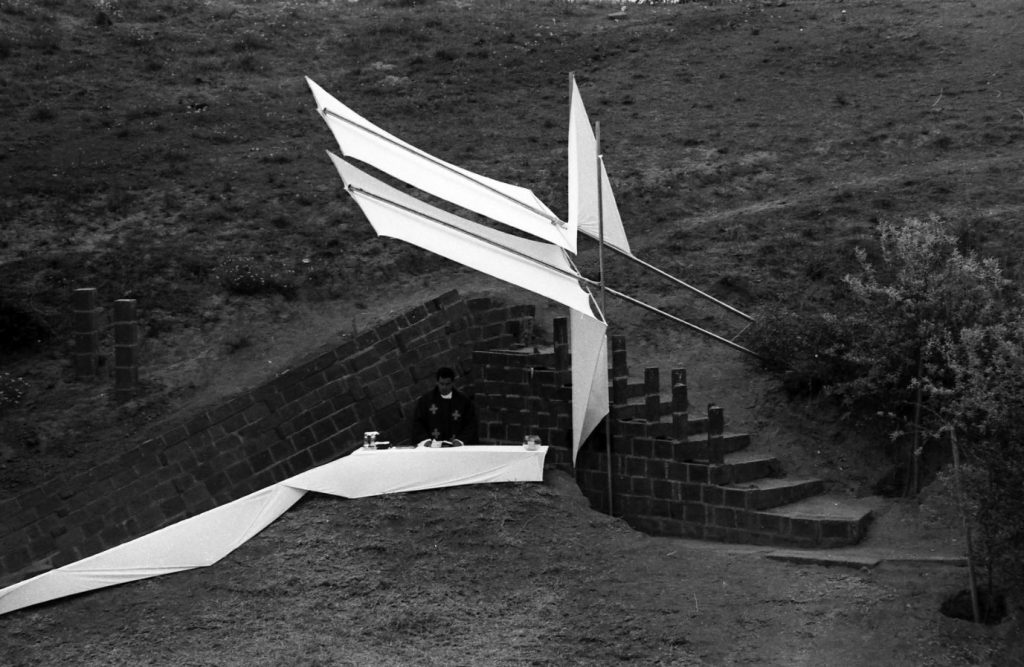
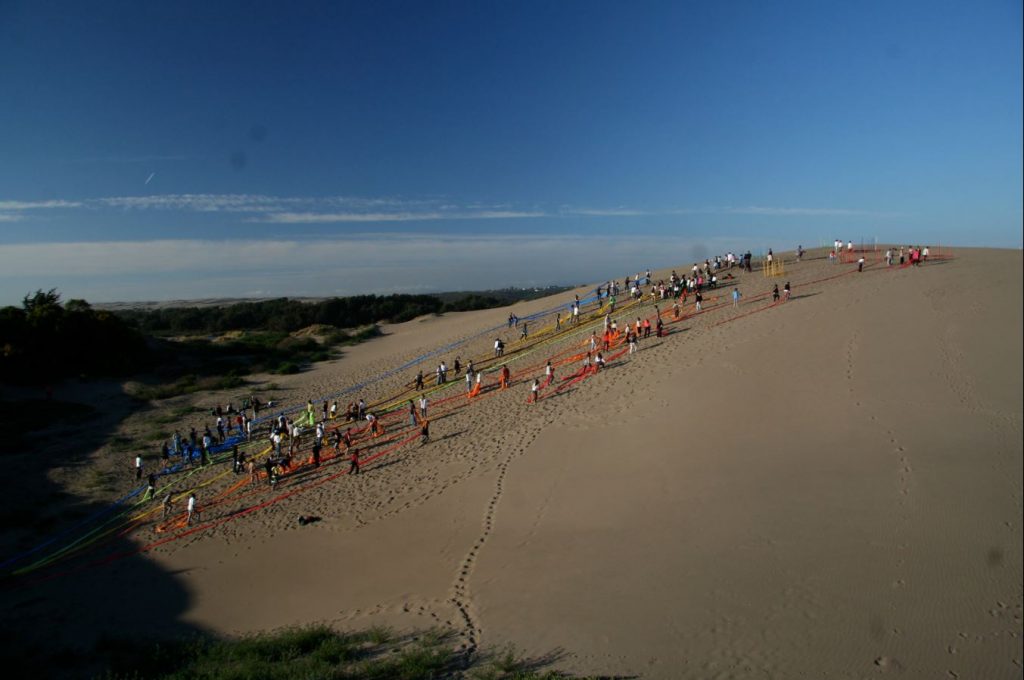
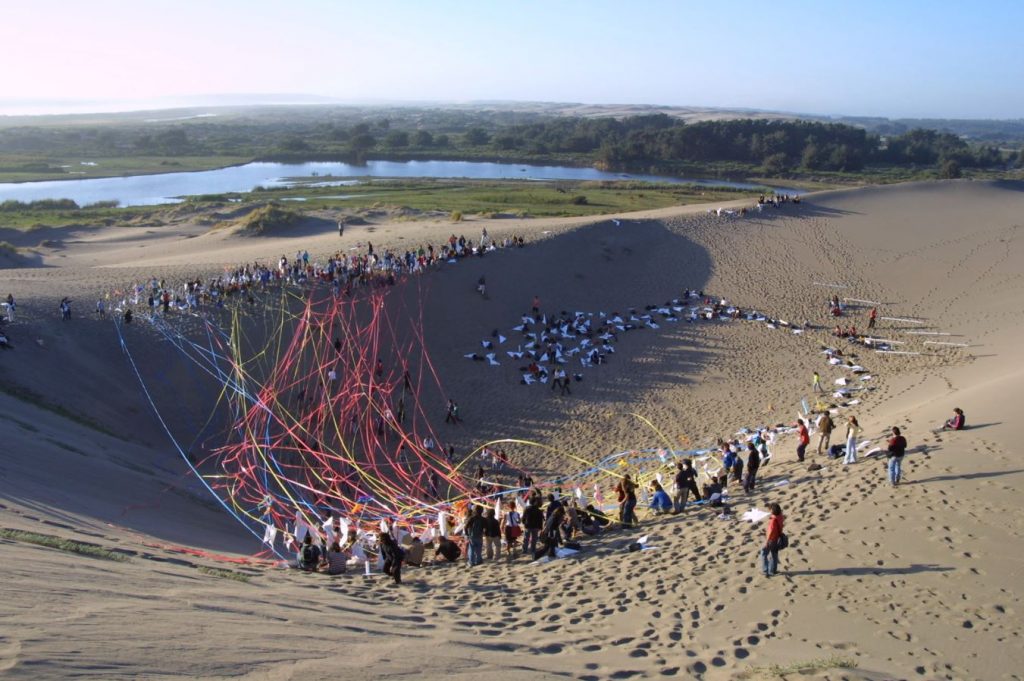
Since its foundation, Open City has established a constant dialogue around pedagogy with the Pontificia Universidad Católica de Valparaíso, hosting weekly classes and workshops in its spaces –such as spatial occupation activities, building workshops and architectural events– and even hosting its students for longer stays. Thus, the cooperative has proposed new contents for the teaching of the School –such as the Indigenous of America, the Music of Mathematics, the Sanctity of the work or the Platonic Dialogues– and has incorporated the experience of the journeys as an integral part of the students development, through the organisation of annual trips since 1984 to some part of the continent in which small architectures are built and given as gifts to the places visited.
Desde su fundación, la Ciudad Abierta ha establecido un diálogo constante en torno a la pedagogía con la Pontificia Universidad Católica de Valparaíso acogiendo semanalmente clases y talleres en sus espacios –como actividades de ocupación espacial, talleres de obra y actos arquitectónicos– y llegando incluso a alojar a sus alumnos para estancias mayores. Así, desde la cooperativa se han planteado nuevos contenidos para la enseñanza de la Escuela –como los Indígenas de América, la Música de las Matemáticas, la Santidad de la obra o los Diálogos Platónicos– y se ha incorporado la experiencia de las travesías como parte integral del desarrollo de los alumnos, mediante la organización de viajes anuales desde 1984 a algún lugar del continente en los que se construyen pequeñas arquitecturas que se regalan a los lugares visitados.
The transcendence that this particular set of buildings may have as a case study or architectural reference is largely due to the singularity of the academic context that has produced and conditioned them, as in the working method that the Open City community applies to its constructions, aspects which are transversal to the design and construction process –such as authorship or ownership– are modified:
La trascendencia que pueda tener este particular conjunto de edificaciones como caso de estudio o referencia arquitectónica es en gran medida deudora de la singularidad del contexto académico que las ha producido y condicionado, pues en el método de trabajo que la comunidad de Ciudad Abierta aplica a sus construcciones, aspectos transversales al proceso de diseño y construcción –como la autoría o la propiedad– son modificados:
“We then conceive and execute the works based on the act of standing upright or not, and we have to look for the elements –floors, walls, spans, ceilings, roofs– that frame the steps taken. In the fidelity to the size that these steps build. A work is thus the relationship between strong steps and framings that try to achieve fidelity. And not the other way round: which is to start from the framings, which are themselves determined by the production and can therefore only deliver the resulting interiors. That is, for us, a mere building and not an officiating of architecture. To officiate it requires that in order for us to build steps with sizes, when stopped by the poetic word, that we build our own bodies. So that they become bodies in Journey.”
“Luego las obras las concebimos y ejecutamos a partir del acto de detenerse erguidos o no, y hemos de buscar los elementos –pavimentos, muros, vanos, cielos, cubiertas– que enmarquen los pasos dados. En la fidelidad al tamaño que dichos pasos construyen. Una obra es así la relación entre pasos fuertes y enmarcamientos que tratan de alcanzar la fidelidad. Y no al revés: que es partir de los enmarcamientos, ellos mismos determinados por la producción y que sólo pueden entregar por ende interiores resultantes. Tal cosa es, para nosotros, un mero edificar y no oficiar la arquitectura. Oficiarla pide, que para que construyamos pasos con tamaños, al ser detenidos por la palabra poética, que edifiquemos nuestros propios cuerpos. A fin de que ellos alcancen a ser cuerpos en Travesía.”
Alberto Cruz Covarrubias, “Ciudad Abierta” (1984)
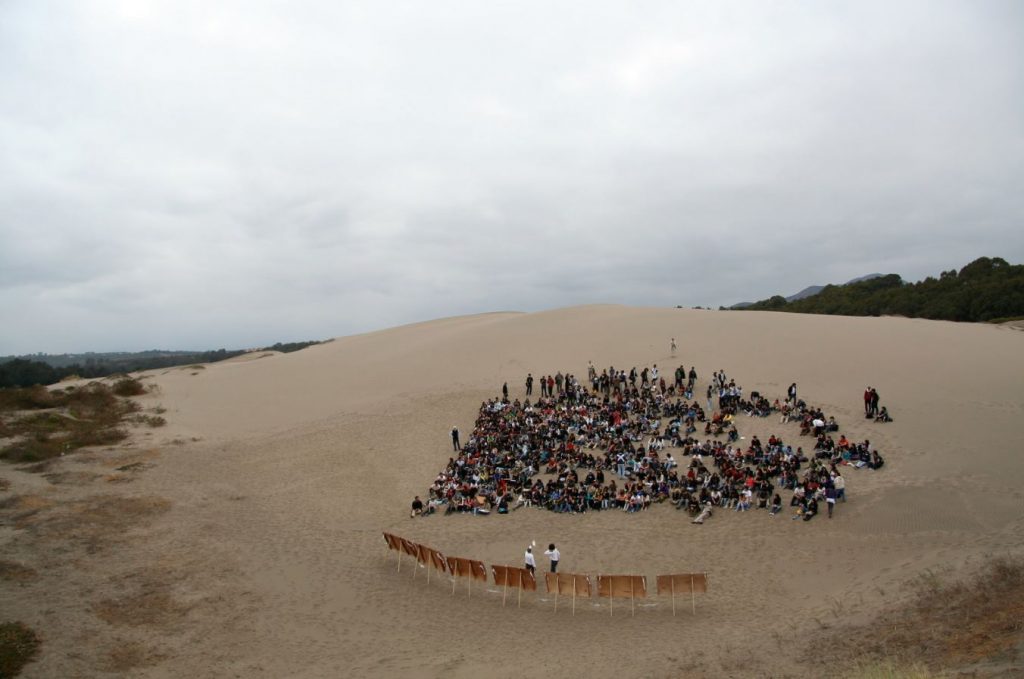
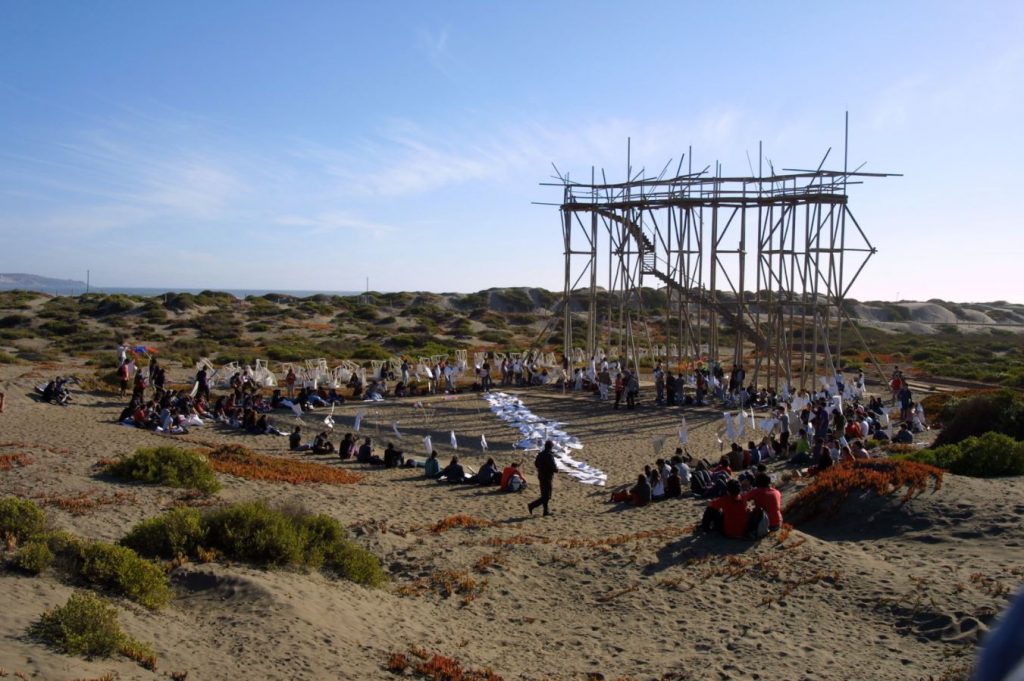
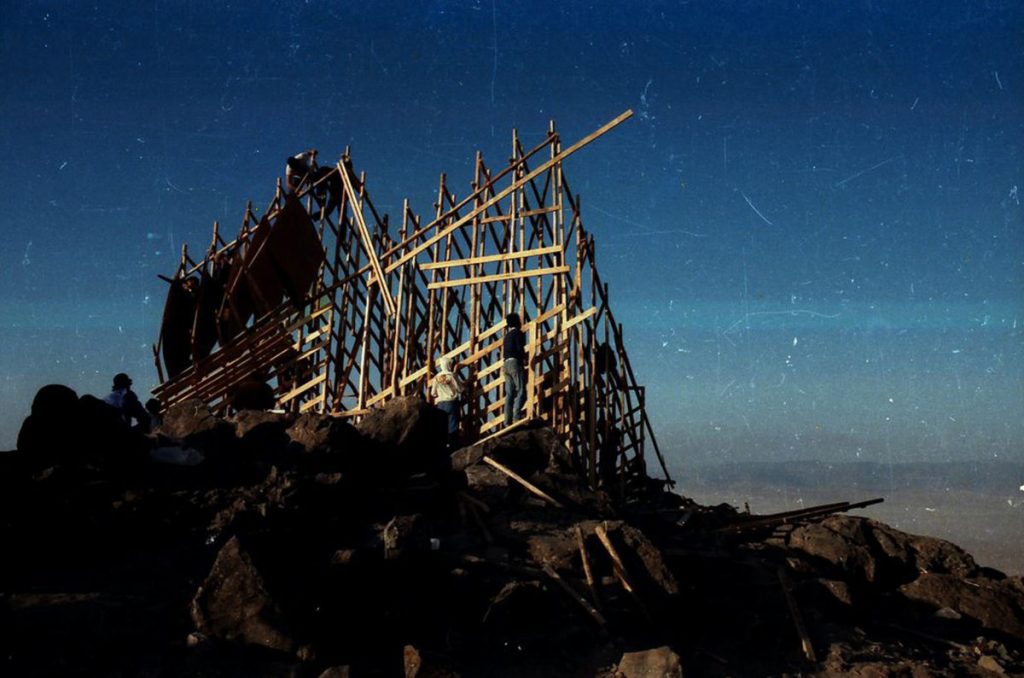
The architecture in Open City speaks an alternative, almost marginal language, but whose longevity and persistence attest to its conceptual solidity: it remained unrelated to the aesthetic movements of the architecture of the 1970s and 1980s, perhaps influenced instead by artistic movements such as informalism, abstract expressionism, arte povera (poor art) or land art. In this way, it seems to arrive to an aesthetic of distortion and apparent chaos similar to that of deconstruction before the dissemination and generalisation of this style.
La arquitectura en Ciudad Abierta habla un lenguaje alternativo, casi marginal, pero cuya longevidad y persistencia dan cuenta de su solidez conceptual: se mantuvo ajena a los movimientos estéticos de la arquitectura de los años 70 y 80, tal vez influenciada en cambio por movimientos de carácter artístico como el informalismo, el expresionismo abstracto, el arte povera (arte pobre) o el land art. De este modo parece llegar a una estética de la distorsión y el caos aparente semejante a la de la deconstrucción antes de la difusión y generalización de este estilo.
“The permanence and continuity of the Valparaíso School for more than fifty years make it, by this single fact, something singular in the architectural global production, and one of the most relevant recent cultural phenomena in Latin America, transcending what could be a typical experience. […] Since 1970 the research and project activity, as well as a good part of the group’s energy, has been concentrated in the so-called Open City.”
“La permanencia y continuidad de la Escuela de Valparaíso durante más de cincuenta años la hacen, por este solo hecho, algo singular en la producción arquitectónica mundial, y uno de los fenómenos culturales más relevantes en la Latinoamérica reciente, trascendiendo lo que pudiera ser una típica experiencia. […] Desde 1970 la actividad de investigación y de proyecto, así como buena parte de la energía del grupo, se concentra en la llamada Ciudad Abierta”.
The reclamation of an American cultural identity –represented in local nature– is the political underpinning of the Open City project: the materialisation of the social and architectural utopia of the teaching staff of the Pontificia Universidad Católica de Valparaíso School of Architecture, through which they managed to link professional activity and teaching with a lifestyle based on the values of their Catholic spirituality such as asceticism or hospitality, and the community practice of poetry.
La reclamación de una identidad cultural americana –representada en la naturaleza local– es el sustrato político del proyecto de la Ciudad Abierta: la materialización de la utopía social y arquitectónica del equipo docente de la Escuela de Arquitectura de la Pontificia Universidad Católica de Valparaíso, mediante la cual lograron vincular la actividad profesional y la docencia con un estilo de vida que girase en torno a valores de su espiritualidad católica como el ascetismo o la hospitalidad, y a la práctica en comunidad de la poesía.
Fernando Pérez Oyarzún, “La Escuela de Valparaíso” in Escuela de Valparaíso – Ciudad Abierta by Rodrigo Pérez de Arce and Fernando Pérez Oyarzún.
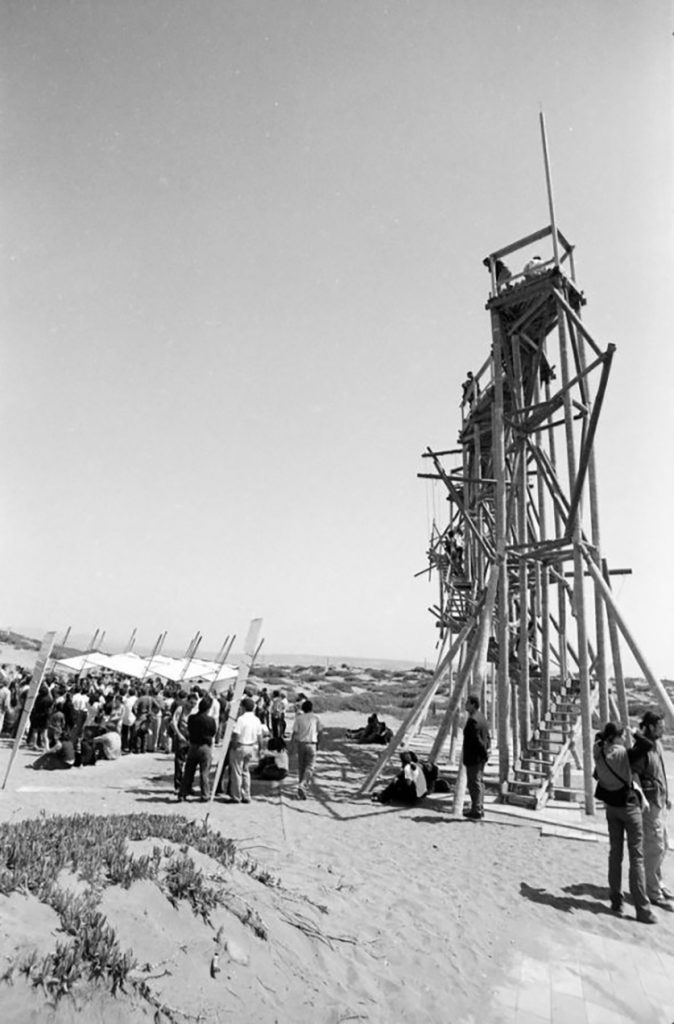

All images and plans, excepting the ones copyrighted, are from Archivo Histórico José Vial Armstrong, Escuela de Arquitectura y Diseño, Pontificia Universidad Católica de Valparaíso.
***
Germán Andrés Chacón is Architect by Higher Technical School of Architecture of Alcalá (ETSAUAH) and Madrid (ETSAM). Former student in Lisboa and Santiago de Chile, currently working in Madrid. He is interested in the theoretical issues of architecture and their effect on the built environment as well as focused on collective housing design. @gandreschacon (Instagram)
